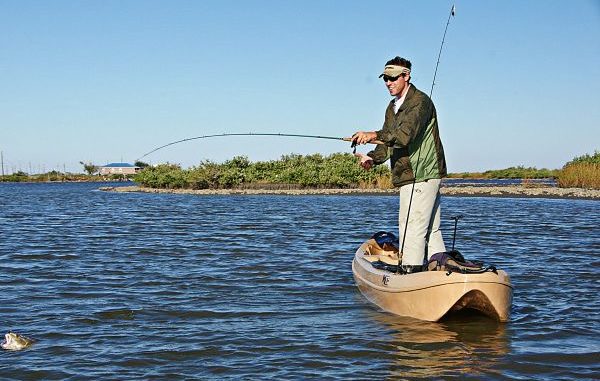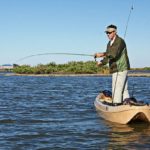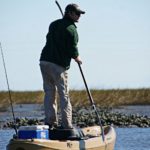
Change of position changes perspective
After three days of northwest winds, the winter cold front left the water in Fourchon only inches deep and muddier than the Mississippi. These conditions don’t build high expectations.
However, the plan was to do some stand-up kayak fishing to sight-fish reds in the dirty, low water. Stand-up fishing in a kayak might sound a little hairy, but with the right equipment you can almost hand-feed hungry reds.
Kayaks are great for getting in very skinny water, but sitting so low makes it very difficult to sight-fish. The guys at Kajun Custom Kayaking Company love to stand up and fish, and couldn’t find a kayak to fit their needs — so they designed their own.
KC Kayaks was founded by four Louisiana State University graduates with a vision “to create the most-stable and comfortable kayak on the market.”
This trip would prove to be a great test for these kayaks. The extremely low water meant paddling in some spots with water as low as 3 inches. Standing up in many kayaks is hard enough; throw in steady 15 mph winds, and most guys wouldn’t even think about it.
It didn’t take long to prove that the KC yaks were up to the task.
Much of the marsh was drained from the strong cold front. KC representative Andrew Chidlow stood and slowly paddled into a shallow pond, all the while scanning for movement or the outline of a waiting redfish.
“There’s one,” he said just before he pitched a soft plastic right into a fat red’s mouth.
With nowhere else to go, the red blasted back and forth across the shallow pond, making it even muddier than it was.
That scene was repeated over and over for the next couple of hours. Within no time, a three-man limit of reds was brought aboard the kayaks. Some of the fish were hooked mere feet from the yaks. If you landed the bait right on the red’s nose, it was a pretty sure bet it would be eaten.
The KC kayaks are great for stand-up, sight-fishing. The hull design offers super stability, and the open deck plan offers plenty of room to maneuver. It adds a level of comfort for those who might be skittish about standing in a kayak.
If your kayak lacks stability for comfortable stand-up fishing, there are ways to turn it into a stand-up fishing machine. “Outriggers” or other extended flotation measures can be added to make the yak much more stable while standing. Outriggers are commercially available, or you can find lots of information on how to make your own with a simple Google search for “kayak outriggers.”
A company called Stand-N-Fish offers a complete system that can turn your sit-on kayak into a miniature technical poling skiff. The outriggers can be raised when not in use so you can paddle without any water drag. When lowered in place, they make it possible to stand and fish with no worries of tipping over.
The padded leaning post puts everything needed right at your fingertips. A tackle box, rod holders, pliers holder and paddle/push pole holder allow you to fish with no need to bend over. The system easily removes for transport with no tools required.
Stand-up sight-fishing adds another level of excitement to kayak fishing — it’s as much hunting as it is fishing. On this day, the conditions allowed for close encounters. You could hit the fish on the head with the lure and they wouldn’t spook, but you won’t always be able to do that. A good general rule is to cast a few feet beyond and work the lure on a crossing path toward the fish.
In the real world, shrimp, crabs and baitfish don’t survive long swimming toward a hungry redfish. If you can make it look like the bait is trying to escape, it will usually trigger a fierce reaction strike.
The best days to sight-fish are when you can find clear, calm water and bright skies. Good polarized sunglasses allow you to spot fish from farther and make a cast before getting too close.
Fish can easily see above the water. If you don’t think so, just watch the nervous reaction when a seagull or pelican flies over a school of mullet or other baitfish. Standing will make you more visible, and the goal is to spot the fish before it spots you. Keep quiet and move slowly.
A kayak allows you to sneak into range of the fish without giving away your presence. Scan in all directions, looking for fish. You will likely not see the outline of the whole fish. It might simply be the white of the red’s lips or the flick of its tail. Look for something out of the ordinary.
When you spot a fish, try to determine which way it’s facing or moving so you can make your cast accordingly. If the fish spooks, don’t give up. Reds will usually swim off a short distance and stop, or even turn around and come back. Stay calm and you might get another shot.
Once hooked, it is generally a good idea to fight and land the fish from the seated position, if at all possible. The sudden moves and turns necessary to fight the fish are best done from a lower center of gravity After a few tries, you’ll figure out how to easily get back down in the seat with a fish on.
In areas where there is soft bottom, a stiff kayak paddle can double as a paddle and a push pole. If the bottom is hard, a lightweight push pole allows you to move along with no noise and little water disturbance. The push pole can also double as a stake-out pole.




